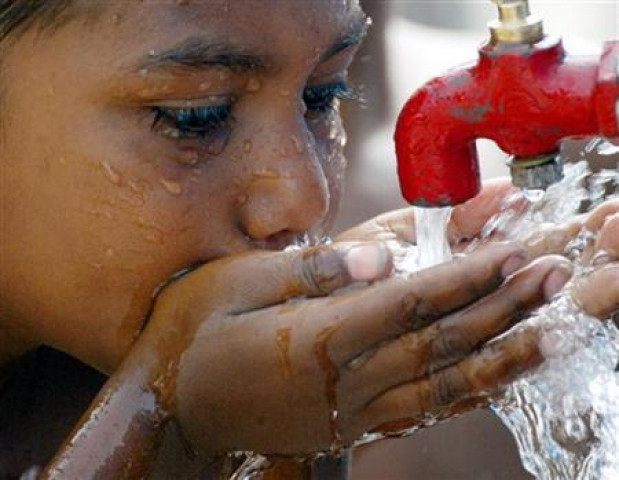Punjab govt drafts plan to provide clean drinking water
It aims to reduce morbidity and mortality caused by water-borne diseases

PHOTO: REUTERS
The policy draft available with The Express Tribune highlights that the key principles of the policy include recognition of safe drinking water as a fundamental right (implicit under Article 9 of the Constitution of Pakistan) of the entire population of the province. The policy focuses equitable access to water and aims at addressing all kinds of disparities in accessing safe drinking water, besides prioritisation of the allocation of water for drinking purposes over other uses, like agriculture, industry, etc.
It warrants appropriate resource allocation for safely managed drinking water services with a delegation of responsibilities and accountabilities to local bodies. The policy will encourage the development and adoption of cost-effective technologies that are easy to operate and maintain for scaling up in the province. It will seek a multi-sectoral approach, involving different government departments and other stakeholders, for ensuring the provision of safely managed drinking water.
The draft also focuses on involving and engaging women and other vulnerable groups in the planning, implementation, monitoring, operation, and maintenance of safely managed water services. It underpins the Sustainable Development Goals (SDGs) with key emphasis on SDG-6 (water and sanitation for all) along with contributing to other goals: no poverty; good health and well-being; gender equality; reduced inequalities; sustainable cities and communities; responsible consumption and production; climate action; and life on land.
The objectives and targets set under the policy show that the government has set a target to create universal coverage and access to safely managed drinking services across the province in line with SDGs by 2030. By 2020, the province will introduce legislative measures and regulations to create an enabling framework for safely managed drinking water services. It will also, devise and implement a need-based criterion for equitable distribution of Water, Sanitation and Hygiene (WASH) resources in the districts, cities and rural settlements. The government aims by the end of the next 10 years, develop standardised service delivery models for urban and rural areas to improve efficiency, access, performance, and sustainability of safely managed water services. It will develop regular drinking water quality monitoring and surveillance mechanisms in line with national drinking water quality standards and SDGs. By 2020, it will also ensure that a minimum 30% of local development funds are transferred to local councils for WASH-related intervention
Another major objective of the policy is to increase public awareness about waterborne and water-related diseases (including polio), nutrition and hygiene, and water safety, including safe water treatment and storage.
A target for 2022 is developing and instituting the capacity development standards and initiatives for implementing, operation and maintenance of safely managed water services. By 2025, it aims to develop and implement mechanisms for reuse, recycle and recharge of wastewater for other municipal and productive uses in all major cities and towns.
The policy document highlights that as per the Punjab Multiple Indicator Cluster Survey (MICS) 2014, about 94% of the population uses an ‘improved' source of drinking water – 89% in urban areas and 97% in rural.
Furthermore, 19.2% population of the province has access to tap water, 41.7% to water from a motorised pump and 30.6% from hand-pumps. The proportion of the population using tap water as the main supply of drinking water is higher in urban areas (39.2%) compared to rural areas (9.6%). Only 2.1% among the household that do not have access to improved drinking water sources were using an appropriate water treatment method, slightly higher in urban (2.4%) than rural areas (1.6%).
As per draft National Water Quality Monitoring Report 2015-16, only 35% water sources in Punjab are safe for drinking, free from microbiological and chemical contamination (iron, fluoride, nitrates) and physical characteristics (turbidity, hardness, total dissolved solids) compared to 31% overall in Pakistan.
Moreover, a Water Quality Survey conducted by Punjab Saaf Pani Company in rural areas of selected districts in 2015 indicates the prevalence of arsenic contamination in almost 40% water sources. The government has been addressing water quality issues through the installation of filtration plants.
The Punjab MICS 2014 found an Infant Mortality Rate (IMR) of 76 per 1,000 live births and Under 5 Mortality Rate (U5MR) of 96 per 1,000 live births. Evidence suggests that pneumonia, diarrhoea, and malaria cause about 50% of all deaths among children in the country.
In Pakistan, 53,000 children die every year from diarrhoea. An estimated 25 million children and 50 million adults suffer from diarrhoeal morbidity annually. According to the Vision 2025 document of federal government, contamination and poor water quality have a direct and very significant impact on the nation's health with waterborne infections accounting for 70% of all common diseases that impact national health. The economic cost of poor water and sanitation services is estimated to be around 3.94% of GDP of Pakistan.



















COMMENTS
Comments are moderated and generally will be posted if they are on-topic and not abusive.
For more information, please see our Comments FAQ